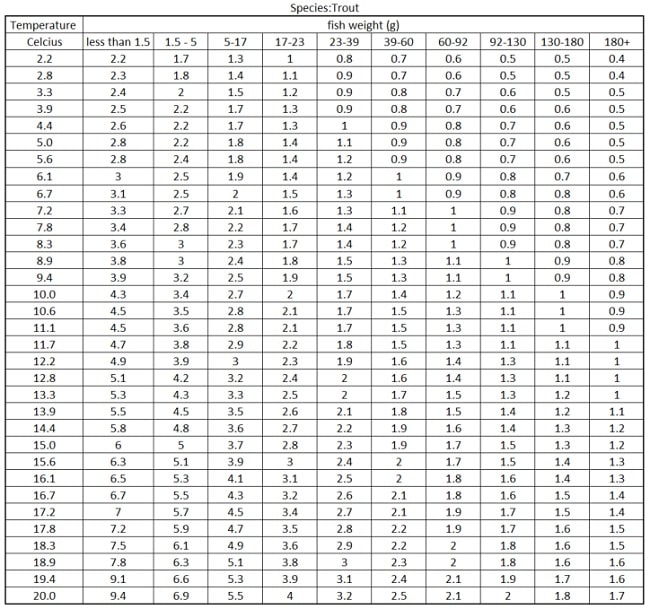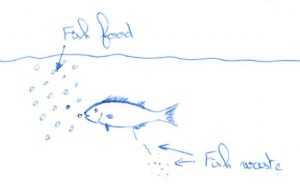The fish biomass correspond to the total weight of fish present in an aquaponics fish tank. But why do we calculate the fish biomass?
Knowing your Fish tank total biomass is important. For the reason that this value will be necessary for the management of your Aquaponics setup. In this article we will see 2 points that require the fish biomass.
Feeding following the feeding tables
Some species of fish raised in aquaculture have been raised for generations. Hence, several studies have been done on those fish. Therefore, the fish food suppliers are able to offer “feeding tables”. They are spreadsheet giving you the quantity of fish food to give to your fish depending on the species, the water temperature and the size of the fish. The data gives you a quantity of fish food to distribute to your fish. The unit is in “fish biomass percent”.

For example, I have an aquaponics system with the following:
- Temperature: 11.3 C
- Trout number: 100
- Trout average weight: 93 g
following the above table, we must feed the fish at 1.1%. Which means that I need to feed the fish 1.1% of the total fish biomass. Here, I have a fish biomass of 93 g x 100 fish = 9.3 kg in my fish tank. Hence, the table recommends to feed 9300 g x 1.1 / 100 = 102 g of fish food pellet per day. You see in this example that we needed to know the total fish biomass (here 9.3 kg) in order to calculate the quantity of food to distribute.
Remaining under the maximum limits of the system

Every Aquaponics system has a maximum capacity to transform the fish waste into plant fertilizer. This maximum limit is determined by the quantity and quality of bacteria present in the aquaponics setup. In a classic grow-bed aquaponics system, this quantity of bacteria is present on the surface of the grow-bed media.
If you build your aquaponics setup following the advice provided into our free 6 STEP Aquaponics guide, you will add a flood and drain system into your grow-bed. This will ensure the environment is 100% aerobic. Which will allow the beneficial bacteria to grow. Hence, they will be efficient into the transformation of ammonia into nitrate.
The total quantity of bacteria will therefore be dependent on the grow-bed volume. Therefore, the larger the grow-bed and the more media volume you will have. Which means more room for the bacteria to grow. At Melbourne Aquaponics we like to give a maximum biomass limit of 1 kg of fish per 50 litres of grow bed. However, this limit is only applicable if your media is highly efficient. See our video about media in Aquaponics for more information.
So let’s take the example of an aquaponics setup with a grow-bed of 250 liters. If we apply the above rule we understand that the maximum quantity of fish we can stock into our fish tank will be 5 kg (250 L / 50 L = 5 kg). Therefore, the only way to know we are not too close to the limits of the system is to calculate the fish biomass of the system.
Now that we understand the utility to know the total fish biomass of an aquaponics system let’s see how to calculate it:
Aquaponics fish biomass calculation
The fish biomass is equal to the total weight of fish in the fish tank. In other words, it is the number of fish multiplied by the average weight of the fish (fish size). The question is “how do you get those 2 numbers which are the number of fish and the average weight?”
Number of fish
In aquaponics like in aquaculture, we generally know how many fish we stock into the fish tank from the day we buy them. Indeed we generally buy fish fingerlings by 50 – 100 or many more. Therefore, we know exactly how many fish we start with. During the raising process, you will probably lose a few fish. Hence, I recommend to keep track of the number of dead fish in a little Aquaponics notebook. In this case you can withdraw the number of dead fish to the number of fish initially bought. As a result, you obtain the approximate current number of fish in your fish tank.
Average fish weight
The average fish weight is continually evolving. Generally and hopefully increasing excepted when you go on holiday and in winter if you live in a cold country. You should keep track of this value. Especially when the fish get close to the plate size and the biomass increases.
In order to do an average weight, simply prepare a bucket with water and weight it thanks to a scale. Then, fish some fish from your fish tank (10 to 30) and put them into the water bucket. Now weight the fish bucket. Once you get this number, withdraw the weight of the water bucket and you obtain the weight of your fish. Divide this number by the number of fish into your bucket and you obtain the average fish weight. Easy!
Now you have your number of fish and your average fish weight so you multiply those 2 numbers and you obtain the fish biomass!
You will probably be interested to discover my six steps to build and manage an Aquaponics system. Click here to access for free! Thanks and good reading 🙂

